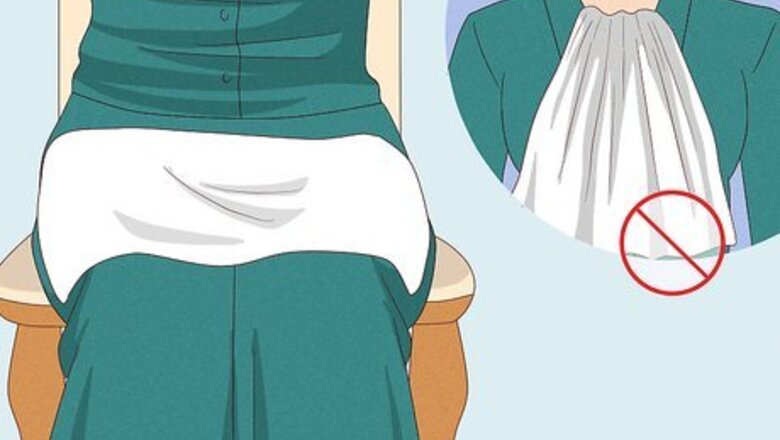
views
Put the napkin in your lap.
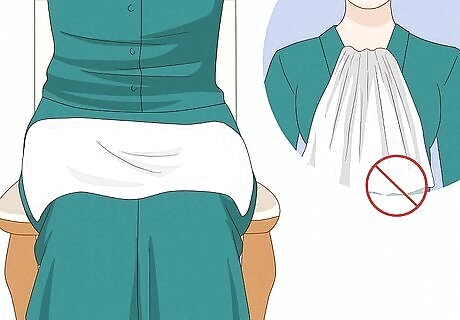
The moment you sit down, set the napkin over your thighs. Don’t stuff the napkin in your collar or leave it sitting there because there’s no food out yet. It’s a little thing, but it’s a big signal to others that you’re familiar with the convention. If the utensils are rolled up in the napkin, place the fork on your left and the knife on your right. If the utensils are already laid out, leave them where they are and just set the napkin in your lap. The exceptions here are lobster and crab legs, but only if you’re eating them by hand. This only applies to formal meals where cloth napkins are already laid out for each place setting. If you’re at a dinner party in someone’s home and there’s a stack of paper napkins in the center of the table, don’t worry about this. While this is mainly an etiquette thing, it will also keep you from ruining your pants! If you’re eating something like sushi and a roll collapses as you’re lifting it with the chopsticks, you’ll be happy that napkin is there.
Familiarize yourself with the place settings.
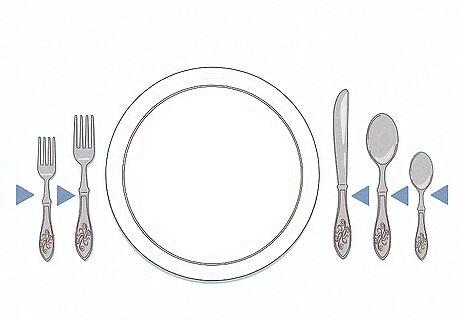
If this looks super overwhelming, take a deep breath. The rule of thumb is that you “work from the outside in” when it comes to the forks, knives, and spoons. So, if there’s a soup starter, grab the spoon all the way on the right. If there’s a small knife and fork on the outer layer, those are for the appetizers. Use the utensils closest to your plate on the left and right for the main course. When in doubt, just wait to see what the other guests do. You can always follow someone else’s cue if you forget what a utensil or plate is for. If there are utensils above your plate, those are for dessert. If there’s a small plate either on top of the dinner plate or next to your utensils, it’s for bread or appetizers.
Take your time and have fun.

This might be the most important component of elegant eating. A meal is a shared experience, not some opportunity to fill up as quickly as possible. Take it easy, chat your friends up, and relax. Eat slowly. Enjoy yourself. Put your fork down to chat in between bites, lean into the conversations at the table, and above all else—just have fun. The goal here is to relish, not fill up! Picture the difference between someone eating a sandwich as quickly as they can while they walk to work, and a laid-back person sitting in front of a sidewalk café slowly snacking on some olives. What’s the difference? Enjoyment! It’s okay if you’re a little anxious about following the norms at a formal meal. Focus on the flavors of the food, the taste of the wine, and the aroma of a fresh meal. Savor it. If you can do that, you’re 90% of the way there as far as “behaving properly” is concerned.
Assemble your bites carefully.
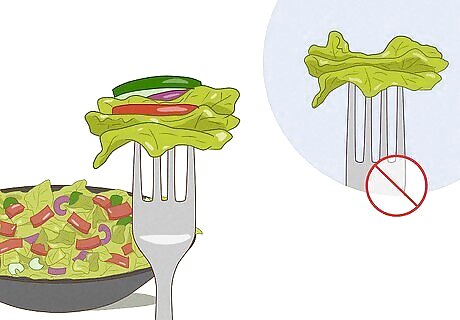
For dishes with multiple components, take your time crafting bites. This is a little thing, but it will make a huge difference as far as elegance and enjoyment are concerned. For something like a chopped salad, use your fork’s prongs to carefully pick out multiple ingredients so that each bite is balanced and flavorful. For a roasted duck over caramelized carrots, try to get some carrot and duck on your fork for each bite. This is a signal to others that you respect fine dining. A chef prepared these dishes for the flavors to balance one another out, and adhering to that code indicates that you appreciate the chef’s work. This isn’t a “burger and fries” situation where the food is meant to be eaten separately. If you do have dish with a side (i.e. a ribeye steak and a double-baked potato), swap back and forth between the two while you eat. The food is also going to just be more dynamic and flavorful if you do this. If there is anything you don’t plan on eating, push it to the outer-rim of your plate so that it doesn’t stand out. It’s totally okay to pass on an ingredient or two, but try not to outright refuse food at a dinner party.
Take smaller bites.
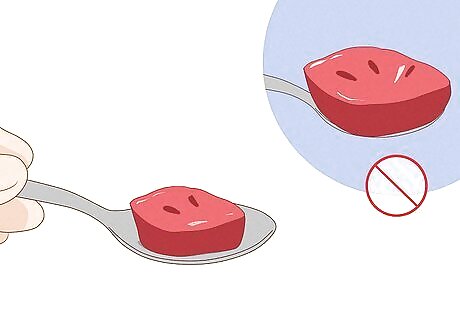
Since speed matters here, taking small bites will help you pace yourself. The bigger the bite, the more likely you are to look inelegant. Huge bites require more jaw movement, which doesn’t look particularly classy. On top of that, it’s hard to say you’re enjoying the food if you’re prioritizing the amount of food you’re eating over the taste of the flavors. This is essential for messier foods. You’re more likely to spill a giant spoonful of jumbo than a small mini-size bite, and watermelon juice will definitely drizzle down your chin if you take a huge bite. Want a unique tip on powdered donuts? Break them into small pieces by hand over a napkin and eat the pieces individually. That way, you won’t end up with powdered sugar all over your shirt. This also helps your body process the food at a more consistent rate, which should keep you from filling up. In a multi-course meal, experiencing every dish is a good idea (both from an etiquette and enjoyment perspective).
Don’t lean over your plate.
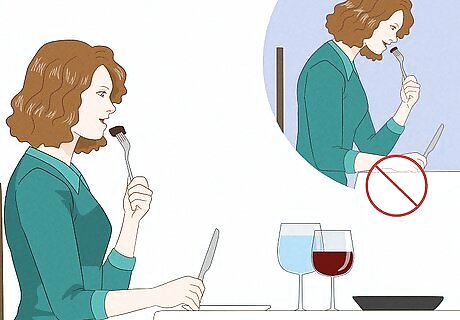
Sit up straight and use your utensil to bring the food to your mouth. Bring your fork or spoon up to your mouth and take your bites from the proper posture. Hovering over your food with the chin above the plate makes it look like you’re planning on making a mess. Work slowly and bring any utensils up to your mouth to take a bite. If you do think you’re about to drop food or spill, bring your off-hand up to help. You can cover your mouth, or catch any spilling food with your off-hand. The less sudden movement you make in these instances, the better. If you’re eating with a fork and knife, do not drop the knife to “switch hands” with the fork. It might take a second or two of practice, but you should be able to guide food to your mouth with your nondominant hand.
Make as little noise while you eat as possible.
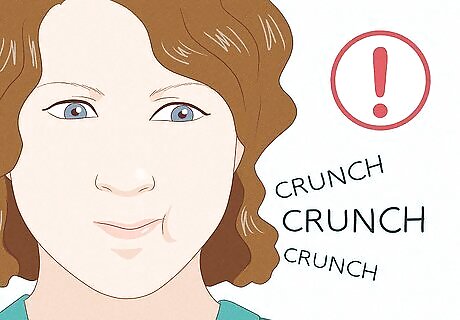
Keep your mouth closed while you chew and don’t make noise. This is another reason smaller bites are a good idea. Nobody likes the sound of someone chewing. Keep your mouth closed when you chew, don’t make noise while you eat, avoid blowing on your food, and don’t slurp your soup. If you’re ordering food at a formal dinner, avoid ordering anything that will be hard to eat quietly. Oysters, corn on the cob, and buffalo wings are the common culprits (although a fancy restaurant may not sell all of these). This isn’t that important if it’s an intimate meal among friends at someone’s home. If the host put out something messy for you to eat, it would be rude to avoid it. Just eat slow, take your time, and use your napkin gracefully.
Tackle super messy foods slowly and strategically.
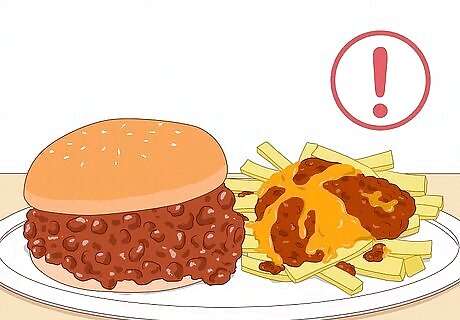
When it comes to foods that are intrinsically messy, think before you eat. Sloppy joes, burritos, and corn on the cob are extremely difficult to eat elegantly, so really take your time and analyze each bite before you take it. You get covered in sauce, grease, or juice when you eat something with passion and forget about the mess. Pausing between each bite will give you time to assess your next move. For buffalo wings, opt for the drumsticks—they tend to be less messy. Hold the ends with both hands using only your index and thumb, and take small bites. You can always eat food with a fork, even if it isn’t meant to be eaten that way. This is helpful for things like chili-cheese fries and candy apples. Pro-tip on saucy sandwiches and hot dogs: don’t put them down. They fall apart and get messy quickly when you set them down and the ingredients separate from the bread. Soup can be a nightmare if you’re trying to eat elegantly at a formal dinner. Try to spoon the soup up by guiding the utensil away from you, not toward you, and don’t put the entire spoon in your mouth. Use the side of the spoon, not the front.
Do not reach over the table.
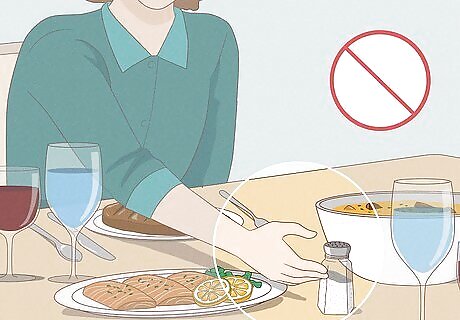
As you eat, ask for things to be passed to you instead of reaching. If you have to place your hand or forearm over someone else’s plate, glass, or dish to reach the salt, ask them to pass it to you. This goes for shared dishes, extra napkins, pepper, grated cheese, and anything else that’s shared among the table. There’s no trick to asking here. Just say, “Excuse me, would you mind passing me the salt?” Don’t feel like you’re bothering anyone by doing this. It’s very common in fine dinning scenarios to ask someone to pass you something.
Wait for permission to move on in the meal.

Let the server bring up dessert—don’t flag them down to ask about it. Whether you’re at a fancy restaurant or you’re at a dinner party, remember that you aren’t in charge. As such, it is best to wait for someone else to take the lead. Even if you really want that fresh bottle of wine, or you’re dying to get rid of that salad and start in on the main course, it’s always classier to wait. If you show up to a party of some sort, wait to be invited to sit down. At a restaurant, let the host guide you to where you need to go—don’t start wandering around or sitting without someone knowing about it. Pushing the schedule forward on your own sends the message that you’re trying to rush through everything, which implies you aren’t enjoying yourself. It’s also kind of gluttonous, since it can appear like you haven’t had your fill and can’t possibly wait.
Do not pick your phone up.
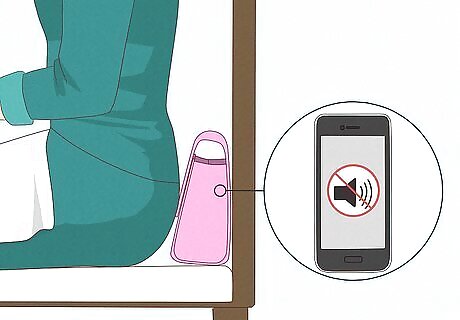
Set the phone to silent ahead of time, and keep it that way. It’s considered kind of rude to be reaching for your phone to answer texts or check notifications if you’re eating among others. If you’re at a fast food joint, nobody is going to care, but if you’re at any kind of formal dinner and you want to exude elegance, keep the phone quiet and out of sight. Part of this is that checking your phone implies you might be checking the time, which means you may not be enjoying yourself. In that spirit, avoid checking your watch if you can. A quick stolen glance is fine, but lifting your wrist up to your eyes to check the time is a little tacky.
Chat with everyone at some point in the night.

At a big meal, start by talking to the folks sitting next to you. There’s an element of elegance that has to do with kindness and comfortability. If it’s a formal dinner where you don’t know the people you’re sitting with very well, extend them the kindness by talking to them first. This also shows that you’re comfortable in your own skin, since it can be a little scary to talk to strangers. It’s considered gauche to ignore the people on your left and right. Do your best to interact with everyone at the meal at least once, if you can. This is an old social convention designed to keep dinners from turning into shouting matches where people are yelling across a table. Keeping the volume at a reasonable level is elegant! Aim to choose conversation topics that everyone can engage in.
Order what the restaurant is known for.
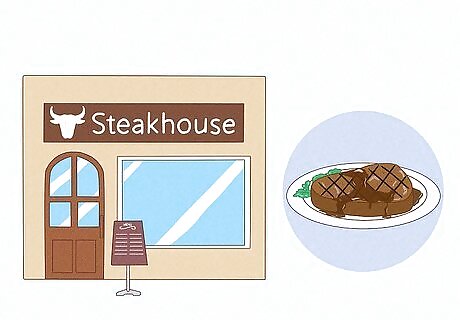
If you’re going out to eat, trust the chef and get their specialty. Order a steak at a fine steakhouse, order the roasted duck that’s on special at a French spot, and get sushi at a sushi restaurant. This does two things. For one, it shows that you have an evolved palate and that nothing is off-menu for you. In addition, it demonstrates a desire for the best. If a spot is known for something, keep it classy and get that. Now, if you have an allergy or you absolutely downright despise whatever the restaurant is known for, feel free to order something else. Just try to keep it in the relative category of what the spot is known for. Don’t get the pad Thai at a trendy new age Thai joint, and avoid the steakhouse hamburger.
Ask questions if you have them.
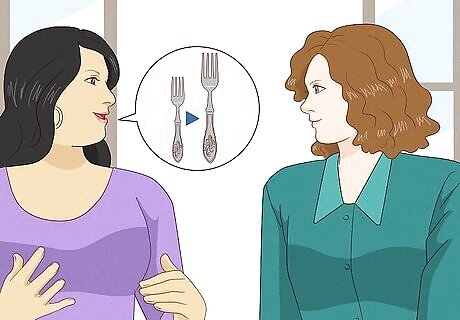
Nobody is going to judge you for having questions. If you don’t know what a dish on the menu is, ask the waiter. If you aren’t sure which fork to use, lean over to the person on your right or left and ask them. Nobody is going to expect you to be a fountain of fine dining knowledge, and there is absolutely no shame in asking a question! Nobody is going to judge you or think less of you for asking for more information. In fact, it may demonstrate your confidence! It takes guts to admit you don’t know something.




















Comments
0 comment